Glenn elicited support from a
They’re drifting up from a passel of eleven mud and hand-hewn
number of local businesses—guitar
cypress timber houses, a re-created Acadian village and the setting stores, a Cajun music label, the local
for the South Louisiana Blackpot Festival & Cookoff.
paper—to help sponsor the event. Fields
Stageside, the sound is loud enough to rumble anyone’s
and fellow organizer, Jillian Johnson,
insides. Most surprising are the youthful faces of the musicians called their musician friends and put
onstage. Three intense twenty-somethings ardently tease notes out together a lineup fifteen bands strong.
of f-holes, voice boxes, and amplifiers, sending the music up and Local bands like Feufollet, the Lost Bayou
down, cresting and crashing, for a crowd a few hundred strong.
Ramblers, the Lafayette Rhythm Devils,
Some dance energetically, a whirl of skirts and denim; others sway and the Pine Leaf Boys were more than
peacefully; those on the picnic benches dig vehemently into
happy to participate.
po’boys and bowls of gumbo. Despite the late calendar date, it still
“The time was right,” Glenn says.
feels like summer.
“It seems Cajun music is hip again. The
A group of disheveled-looking college students occupy one
popularity of Cajun music and culture
of the picnic blankets.
swings back and forth—there was an
“We love the music, the heritage, the dancing, being
upswing in the 1960s and 1980s, and now
outdoors,” says Lacey Dupré-Bacqué, a master’s student in organic the pendulum’s swinging back up again.”
gardening at Louisiana State University.“This corner of Louisiana is The Blackpot Festival is an annual
special because our traditions are rich, abundant, still very much event, and welcomes visitors from across
alive, and maintained by young people.”
the country—young and old alike—to
Indeed, smatterings of French—both Parisian and
join the festivities. A writer for Smithsonian
Acadian—erupt at random. As one woman, handing out samples
who attended the festival, later wrote,
from a local health food store says,“It’s at festivals where everyone
“Twenty-somethings with tattoos shared
intersects: the hippies, the old-timers, the families.”
the floor with dancers in their seventies, all of them swinging and swooping and hollering.
Jeremiah Ariaz, a young art professor who’s just moved to
Cajun culture, it would seem, is alive and well, and ready for another century.”
Baton Rouge from Los Angeles, admits to being surprised by how
One vendor summed it all up:“Compared to the processed pop music we hear deeply he’s enjoyed Cajun music and festivals like Blackpot.
today, Cajun music’s totally organic. It’s homegrown stuff. Nutritious, you know? That’s why
“The South has a very distinct culture that’s absent in a lot of parts of the it feels so satisfying.”
country,” he says.“But people here embrace it. It makes for a lot of fun.”
134 : o u t s t a n d i n g y o u t h
u n c o m m o n w i s d o m : 135
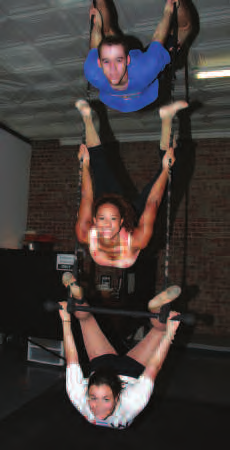
Pegi returned to Portsmouth after she retired from the Vero Beach Recreation Department in Florida, where she originated a similar program—Aerial Antics Circus.
Steel Mills to Circus Arts
She soon began working as the performing arts curator at the local Southern Ohio Museum. People began asking her to teach a small dance class for children, so Pegi applied for and received a couple of grants. That was the beginning of Cirque d’Art.
Pegi sits surrounded by several of her students. She says,“I’ve learned that the love of the art is sharing it, not in doing it yourself.”
Cirque d’Art began officially on September 11, 2001—a difficult time to focus on the performing arts if ever there was one. Nevertheless, Pegi rented the studio with ohio : cirque d’art theatre
her own money and began offering circus classes to local youth. Cirque d’Art has a sliding-pay scale that goes down as low as fifteen dollars per month. Some of her Appalachian towns hard hit by the loss of mining and industrial
students cannot even afford the smallest fee, so she finds local sponsors to make up the jobs often struggle just to get by, and they usually don’t support a thriving difference so that anyone can dance.
arts community, let alone launch successful circus and dance programs for Trisha Schmidt is Cirque d’Art’s assistant director and is also a physical therapist hundreds of local youth.
who works at the local Vern Riffe School. There she incorporates dance, movement, and Cirque d’Art Theatre is the brainchild of Ohio native and former circus arts into her programs for youth in wheelchairs and with other physical professional circus performer and dancer Pegi Wilkes of Portsmouth. Pegi disabilities. This kind of unorthodox therapy not only helps improve coordination and teaches people, young and old, how to perform lively and creative circus health, but also provides a fun alternative to the typical routines of physical therapy.
acts that they never imagined they could accomplish. Pegi’s former Trish began working with Cirque d’Arts in 2003 when she was thirty-two and her young students teach most of the classes, which even the lowest-income daughter went on a field trip with her kindergarten class to see the circus. Trish called students can attend, thanks to diligent grant writing, community support, Pegi the next day and has been hooked ever since.
and the group’s passion for their art.
Courtney Speck, seventeen, has become one of Cirque d’Art’s most talented Students learn not just acrobatics and circus arts, but also
As America’s youth become increasingly
performers, beginning to dance when she was twelve. Courtney plays the gargoyle in teamwork and dedication. They often go on to dance in college and some obese and inactive, dance provides a social,
Cirque d’Art’s haunted Halloween show. She eerily climbs up and down a rope as the even go on to professional circus careers. Success learning circus routines creative, and noncompetitive way for young
public gasps at other ghoulish gymnastic feats. The show consists of acrobatic skits that on gym mats and hanging hoops translates surprisingly well to success in people to get exercise and shrug off the
reinterpret fairy tales: instead of Rapunsel allowing the prince to climb her hair, she their relationships and jobs.
stiffness caused by hours in front of a
strangles him! Pegi laughs and says,“Yes, we have a dark side!” She goes on to explain, Portsmouth sits on the northern banks of the wide and murky
computer or television.
however, that while circus dance may seem just like a fun after-school activity to some, it Ohio River in the Appalachian foothills of Southern Ohio, right on the also teaches skills that could save one’s life.
Kentucky border. For the past several decades, big steel mills, uranium
“Everyone should know how to climb up or down a rope or quickly descend a enrichment, and railroad businesses have slowly left the area. Population ladder backwards,” she explains. The state of Ohio no longer considers physical peaked in 1907 at 50,000, compared to today’s roughly 21,000. The decline education a mandatory part of the curriculum, so grant-driven programs must often of heavy industry and lack of good jobs make it very difficult for many pick up the slack. As America’s youth become increasingly obese and inactive, dance residents to get by, let alone pay for extracurricular activities. More than provides a social, creative, and noncompetitive way for young people to get exercise half of the performers in Cirque d’Art Theatre are on scholarships to attend and shrug off the stiffness caused by hours in front of a computer or television. Cirque the classes.
d’Art creates an engaging social atmosphere and breaks down racial barriers as The young performers explain there isn’t much to do in
evidenced by the diverse array of students.
Portsmouth, which lacks a YMCA or recreation department and has only Heather White, seventeen, recently began participating after being persuaded two movie theaters and a small mall. With a large studio space, friendly by a friend. She was incredibly shy before beginning to perform with Cirque d’Art.
atmosphere, and skilled instructors, Cirque d’Art has grown from 50
“Everybody encouraged me to try new stuff and they accepted me for who I am,” she students in 2003 to over 250 today.
says. The atmosphere in the high-ceilinged studio is one of mutual encouragement.
136 : o u t s t a n d i n g y o u t h
u n c o m m o n w i s d o m : 137
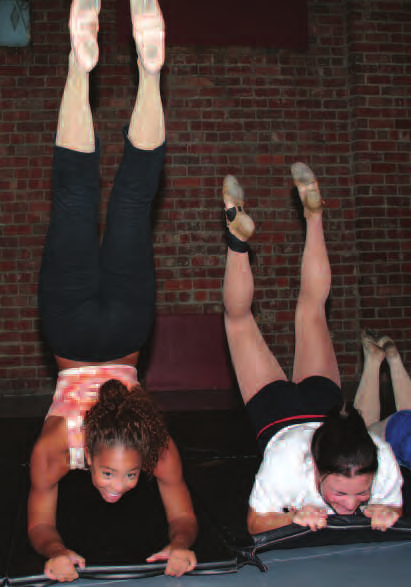
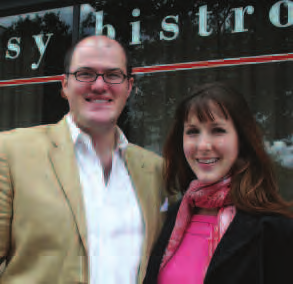
Students expand their capabilities one
baby step—or contortion—at a time. In
Creating for 100 Years
addition to attracting students from a
wide range of ages and socioeconomic
backgrounds, Cirque d’Art has a healthy
contingent of young men participating as
well. This is something that many
performing arts classes don’t see,
especially among teenagers.
illinois : nathaniel & kerry brooks
Jon Chandler, twenty-one, was
very skeptical when he first attended a
In a world of increasingly shoddy plastic tools and
circus dance class, but soon discovered
toys, Nathaniel and Kerry Brooks create dwellings and
the thrill and intense physical challenge of
artwork that last for generations. As an architectural
tumbling and aerials. Physically strong and
designer, Nathaniel specializes in historic restoration and
experienced performers like Jon often do
preservation, rejuvenating generations-old structures.
adagio, where one person supports
Nathaniel fights to save historic buildings in small town
another in the air. Adagio requires that
Quincy, Illinois, and designs new structures based on local
both performers work together and
traditions. Kerry is an internationally-recognized artist who
perfect their balance and timing as one or
brings art appreciation, shows, and fairs to the Quincy area,
the other climbs and twists into the air. In
while painting portraits that may become heirlooms.
the shows, only the more experienced
A small town allows this young, creative couple
performers take on these moves while
to make significant contributions to the community, to
younger performers turn cartwheels and
enjoy peaceful work time, and to actually sit down on
complete more simple routines.
their front porch for lunch together—a difficult task in
Since Cirque d’Art’s founding,
larger urban settings.
Pegi has seen remarkable progress in
In the rosy evening, Nathaniel relaxes in a wicker
many young people. These circus dancers
rocking chair on the wide front porch of the century-old
from the small town of Portsmouth, Ohio,
house the couple purchased. Gazing through the large old
have gone on to college, when no such
willow trees, whose tendril-like boughs gracefully brush
plans existed before. Some have even
visitors as they walk up to the entrance, his trained eye
become professional dancers. Performing
surveys the neighborhood.
with Cirque d’Art demands intense
“Just on this one street you learn so much about
teamwork, physical problem solving, and
the development of architecture in the U.S.,” he says. The Brooks bought their home from the kind of dedication that can help youth
a family who had owned it for over a century.
succeed at virtually any task. Christin
In addition to historic preservation, Nathaniel promotes New Urbanism, a style of White, twenty, sums it up,“It teaches you
architecture and urban planning characterized by mixed-use, walkable communities to try anything. You may not be able to do
where centralized downtowns lessen the necessity for driving. Residential spaces top first it, but you’ll try anything in life. And no
floor retail shops, and zoning allows people to live near their work, parks, public buildings, matter what somebody throws at you, at
and the stores that sustain them. This paints a rosy picture, but Nathaniel laments the fact least you’ll know how to approach it.”
that successful New Urbanism developments often price out low- and some middle-income residents due to their popularity.
138 : o u t s t a n d i n g y o u t h
u n c o m m o n w i s d o m : 139
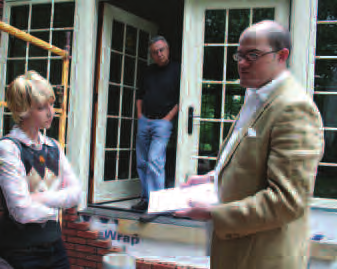
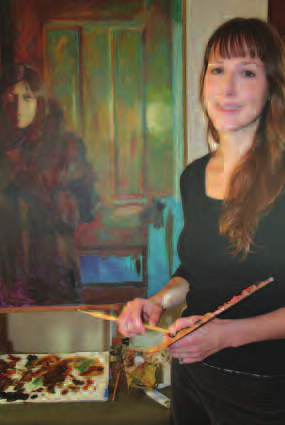
Nathaniel went to Judson University near Chicago and met Kerry though their Life in Quincy draws more young professionals than ever, as evidenced by several mutual friend Nadine. (Nadine now manages the Busy Bistro, a local restaurant housed of the couple’s college friends moving in and starting new businesses. In his office, in a building Nathaniel renovated.) Kerry got her bachelor’s degree in Russian at the Nathaniel works with Nicole, an intern from Judson who recently completed her bachelor’s University of Illinois in Chicago. She lived in Russia and the Ukraine where she studied in architecture. Nicole commutes to work from her family’s farm in nearby Hamilton, where art in the academies in St. Petersburg and Kiev. The two art lovers were married in 2001.
she is the fifth generation to have lived on that land. At a time when small town America Kerry worked as a portrait painter while Nathaniel finished
watches its youth leave for lack of jobs, Quincy, with its wireless access, riverfront, and his Master’s degree in Architecture. Then it was Nathaniel’s
restorations, seems to be experiencing a revival.
turn to work for the Studio for Civil Architecture in New York,
Half-squeezed paint tubes and intriguing portraits of women and landscapes fill while Kerry undertook post graduate work at the New York
Kerry’s upstairs corner studio in their home. She recently created an installation at the local Academy of Art.
hospital and travels to schools teaching students
Nathaniel still works from Illinois for his New York
about art and being an artist. She finds it easier to
employer on restoration and design projects that often have
get involved in small communities where most
him traveling across the nation from the tiny Quincy airport.
people often know each other. One of Kerry’s
He recently finished work on a Dutch colonial style house in
recent projects has been a series of thirteen
Connecticut, built in the 1780s, which had suffered several
paintings of female friends and family members
haphazard additions in the 1950s and 60s. He re-exposed the
who have impacted her life.
original fireplaces that had been walled over and used
“I’m kind of fascinated by the beauty I
reclaimed wood to complement the house’s original broad
find in my friends and family. They’re ordinary
floor boards. The Connecticut owners loved Kerry’s paintings
women, but each has their own personality and
and bought several to adorn their home.
style,” she says.
Beyond their professional work, both Nathaniel and
Both Nathaniel and Kerry create works
Kerry involve themselves in the Quincy community. Nathaniel
of art meant to last, and both spend enormous
sits on the board of the nearby Gardner Museum of
amounts of time planning and designing their
Architecture and Design and is a member of the Quincy
artistic endeavors. Nathaniel explains that most
Preservation Commission that evaluates all demolition permits
modern “stick-built,” vinyl-sided houses often
and oversees historic structure modifications. He also
only last through the initial thirty-year
participates in the Historic Quincy Business District, a group of mortgage before beginning to lose value,
local business owners that plans programs to promote local
whereas well-built houses gain value over time
commerce. Recently, they brought free Wi-Fi access to the
and last for centuries.
downtown and riverfront.
He adds,“To me the task of architecture
Nathaniel shakes his head as he explains how he
is wrought with responsibility because you’re
fought to preserve historic buildings along Quincy’s
doing something that’s going to last for hundreds of years.”
riverfront, and then got hired to help design condos in their
Similarly, Kerry’s portraits and other paintings become treasured family place by the very people that demolished the older
heirlooms that people use to connect with and remember their relatives.
“To me the task of architecture is wrought
buildings. Nathaniel laments the disconnect between past
The couple feels lucky to have been exposed to those in less fortunate with responsibility because you’re doing
and present; between a sense of tradition and modern
circumstances and has decided to adopt a child or children from Kazakhstan. Kerry will something that’s going to last for hundreds
development needs. His college thesis,“The Architecture of Civic Presence,” dealt with teach their children Russian and help them begin an intercultural life without forsaking of years.”
these very issues, exploring how the built environment helps create community spaces their heritage. Nathaniel and Kerry are eager to bring some more life into their antique and promote civic engagement. He believes that buildings not only teach us about our house in Quincy and feel confident about raising children in the community. With their past and our heritage, but also help shape the future and influence our moods, roots growing apace with Quincy itself, the Brooks’ eagerly anticipate tiny new artists to relationships, and lifestyles.
join them.
140 : o u t s t a n d i n g y o u t h
u n c o m m o n w i s d o m : 141

The New Old Timer
Part-time university student and part-time, world-traveling fiddle player, Todd grew up on an eighty-acre farm that raised cows and tobacco.“Tobacco’s not so good anymore,” he says.“People are finding different things to farm.” Thankfully, Tennessee has a growing industry that is much less pernicious to the lungs—music, and the tourism it attracts.
As a boy, Todd began weekly fiddle lessons with teacher Scott Gould. A quick study, he knew nearly 200 songs after five years. Soon he was jamming Tuesday nights in Bristol (the alleged birthplace of country music), Friday nights in Bluntville, and tennessee : todd meade
Saturday nights at the Carter Family fold in Hilton.
“Back when I was growing up, it was just me and a bunch of old men,” he reminisces.“Now, there’s a lot more interest in roots music.”
In high school, Todd was asked to put a band together to fund raise for the National Honor Society. (“I wasn’t in the honor society,” he specifies, grinning.) Made up of classmates and relatives, the band,“Twin Springs,” was such a success that they recorded a CD. It wasn’t long before Ralph Stanley came knocking. Stanley gained widespread fame for his appearance in the 2000 movie hit, O Brother, Where Art Thou?
In the early 1950s, Ralph and his brother Carter Stanley were pioneers of modern bluegrass music, along with Bill and Charlie Monroe, Earl Scruggs, Lester Flatt,
“Back when I was growing up, it was just
and a host of others. A Library of Congress Living Legend, Dr. Stanley has been me and a bunch of old men. Now, there’s
called the best banjo picker in bluegrass. Now in his seventies, he still tours 200 days a a lot more interest in roots music.”
year. Shortly after Todd’s 18th birthday, Ralph handed Todd twelve CDs and said,
“Learn these.”
“The first time I played with Mr. Stanley was in front of a thousand people and a bunch of cameras,” Todd recalls.“I was so nervous. He’s such a legend.”
On the job just a week, Todd was told,“‘Pack your bags, tomorrow we’re going to California for two weeks.’ It was my first time ever on an airplane,” he adds.
Todd spent 250 days on the road that year.
“I’ve been to every state in the continental U.S.,” he says.“If I haven’t played there, I’ve driven through it.” He adds, wistfully,“We didn’t do much other than play, though. I didn’t see states so much as interstates.”
After a year of touring, Todd enrolled at East Tennessee State University, the only four-year college with a bluegrass major. Half the week he tours with the band, Carolina Road. He plays bass and fiddle. Classes are squeezed into strictly delineated slots during the other half of the week, arranged so they won’t interfere.
Critics deride bluegrass—a “modern” offshoot of old-time music—as “too Nashville”—in other words, too commercialized, too formal, too given to arrangement.
Old-time music, Todd explains, is freer, looser. It’s mountain music, whose melodies are sometimes recognizably Celtic. There are no solos, and often no lyrics; the musicians
“I grew up listening to my great-grandpa fiddle,”says Todd Meade, with a all play all the time, shuffling their bows or strumming their banjos “claw-hammer gentle, dimpled drawl.“He lived to be a 101, but died when I was 7. I started playing style.” It’s music that puts people in a dancing mood. They “flat-foot” or square-dance after that.”
142 : o u t s t a n d i n g y o u t h
u n c o m m o n w i s d o m : 143
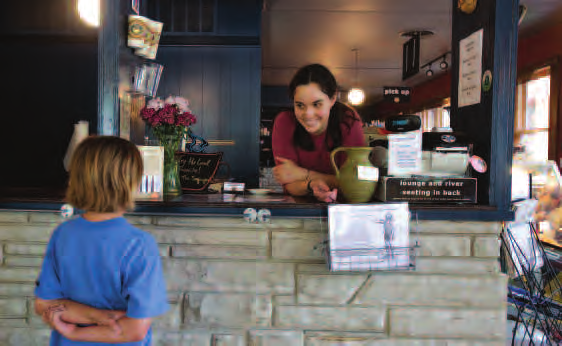
or clog. The sound is highly local, and Todd claims he can tell the Carolina and Tennessee fiddlers apart.
Tribal Grounds & LIFT Culture House
“I like both,” he shrugs.“My favorite, really, is old-time, but I can’t make a living playing just that. And I love bluegrass too.”
Undeniably, bluegrass has changed the face of roots music. O Brother’s critically acclaimed soundtrack sold five million copies and propelled bluegrass and its melodic kin into the limelight.
“It proved we weren’t just a bunch of bib-wearing, toothless hicks singing through our noses,” says Todd.“Although some of the old-timers grumbled, it has made north carolina :
festivals a lot more hip and fun,” he adds. Some of Todd’s favorites are the Old Fiddler’s Convention in Galax, Virginia, and the Appalachian Music Festival in Clifftop, West leon grodski & natalie smith
Virginia. Festival goers—and some performers—come from as far away as Europe, Australia, even Japan, and young and old alike jam until the early hours.
Savvy business leaders and politicians are adding roots and bluegrass music into their economic and cultural development plans—promoting local museums, instrument makers, and festivals. The music is ubiquitous, and formal jams are organized while informal ones coalesce at random. Blue Ridge Country magazine, with whom Todd collaborates, also works to promote tourism in the entire area. Nashville
“It proved we weren’t just a bunch of
has its own branding agency, which markets and sells Music City as a “premier bib-wearing, toothless hicks singing
entertainment destination for travelers who seek authentic and unique leisure and through our noses.”
convention experiences.”
The bureau has fifty employees whose goal is to grow Nashville’s second largest industry, which already garners the city three billion dollars a year. Although Nashville also houses the Museum of Tobacco Art and History, more people are coming to Tennessee for the music.
“It’s a positive thing,” Todd believes.“It can bring money into the area. People think they need factories, ATV trails, more logging—that it’s okay for the mountain to slide into the streams.” His voice falls to a whisper, takes on the tinge of the confessional:“I think I’ve become a bit of a Democrat!”
He blames the traveling.
Back at his apartment, Todd has a rehearsal scheduled with roommate and banjo-playing bandmate Josh Goforth. Besides the banjo and two fiddles, a mandolin is propped up against the wall and an upright bass case sits on the floor. When these two
“college boys” begin practicing, exchanging wordless nods and looks, the melodies and harmonies of old-time favorites like “Arkansas Traveler” and “Angeline the Baker” seem to waft up through the rafters of their townhouse and float over the Wal-Mart and barbecue joints before fading into the cold Tennessee night air.
“Some days we have knitting at five, art at seven, and heavy metal at nine, and some people are staying for all three,” Leon Grodski says with a laugh as he describes the eclectic program offerings at LIFT Culture House in Cherokee, North Carolina. Leon and his partner, Natalie Smith, opened LIFT in 2004.
144 : o u t s t a n d i n g y o u t h
u n c o m m o n w i s d o m : 145

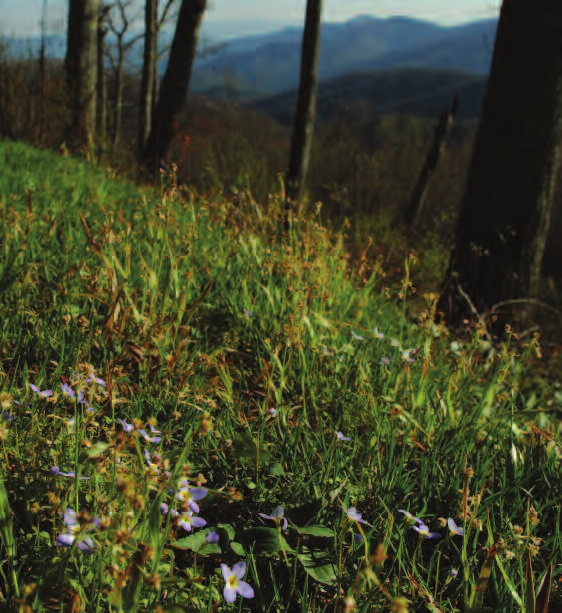
While Leon and Natalie were both at Western Carolina University, where Leon was an artist in residency, they crossed paths only a moment before Leon was to go to Europe. Like in the movies, they knew they wanted to be together, so they spent the next few months touring Slovenia, Italy, and Tunisia. Both wanted to come back and develop their concept of a “culture house,” where people could come tog












